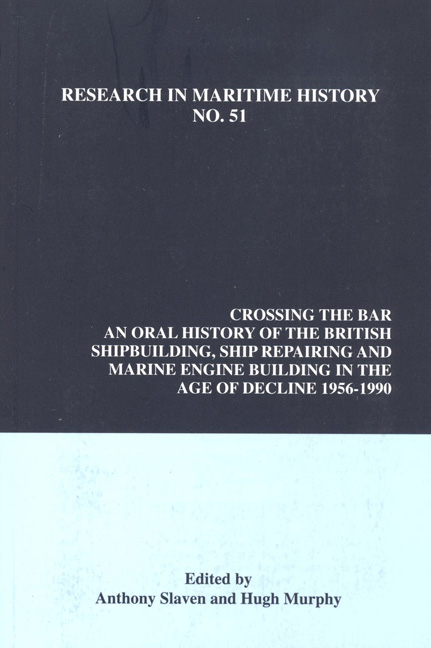 Crossing the Bar
Crossing the Bar Book contents
- Frontmatter
- Contents
- About the Authors
- Dedication
- Preface: A Shipbuilding Libretto
- Introduction
- Interviews
- Lower Clyde
- Upper Clyde
- The Tyne
- The Wear
- Barrow-in-Furness
- The South Coast
- 28 Peter Usher, Vosper Thornycroft
- The Humber
- Belfast
- British Shipbuilding Industry Officials
- The Trade Unions
- The Civil Servants, Board of Trade, Shipbuilding Enquiry Committee, Shipbuilding Industry Board, Ministry of Technology, Department of Trade and Industry, Department of Industry
- The Politicians
- Interviews British Shipbuilders Plc
- Conclusion
- Select Bibliography
28 - Peter Usher, Vosper Thornycroft
from The South Coast
- Frontmatter
- Contents
- About the Authors
- Dedication
- Preface: A Shipbuilding Libretto
- Introduction
- Interviews
- Lower Clyde
- Upper Clyde
- The Tyne
- The Wear
- Barrow-in-Furness
- The South Coast
- 28 Peter Usher, Vosper Thornycroft
- The Humber
- Belfast
- British Shipbuilding Industry Officials
- The Trade Unions
- The Civil Servants, Board of Trade, Shipbuilding Enquiry Committee, Shipbuilding Industry Board, Ministry of Technology, Department of Trade and Industry, Department of Industry
- The Politicians
- Interviews British Shipbuilders Plc
- Conclusion
- Select Bibliography
Summary
I began my career at Chatham Dockyard as a shipwright apprentice. I graduated to become a member of the Royal Corps of Naval Constructors, and had five years of training. I then joined the Ministry of Defence at Bath as an assistant constructor in 1951. In 1966 I saw an advertisement for a technical director at Vosper Thornycroft, was successful in my application, and subsequently held that post for eight years. I then moved into production for eight years and took over as Managing Director working under a Chairman appointed by British Shipbuilders from 1981 until the firm was privatised in 1985. I led the management buyout bid for Vosper Thornycroft, and in 1985 we succeeded and bought the company. I was the Chief Executive when we floated the company on the Stock Exchange, and became Chairman in 1990, a post I still hold today.
Vosper Thornycroft was created by a merger in 1966 of Vosper Limited, a Portsmouth-based company, and Thornycroft, a Southampton based company. I joined them as the two companies merged. The major strength that we had then and still have is a foothold into the export market for warships, which was very new in those days. We achieved good orders throughout the period of the late 1960s and early 1970s. We were growing at something like a rate of twenty percent per annum, and when nationalisation came in 1977, not surprisingly it was strongly resisted by the major shareholders led by Sir David Brown. Our case was that we had a good order book, a good cash position, and we could see, therefore, no advantage in being nationalised. No one at the company felt that we had a weakness, but I suppose relative size was one. We were making about £3m to £4m profit. We were not a huge company, but we felt that we were big enough to survive on our own. It could be said, however, that our weakness was that we were overtrading. We had a very large order book, and were insufficiently capitalised. Vosper Thornycroft was different because we were orientated to the export market selling small fast patrol boats etc. In the late 1960s we invested, and in 1970 put up a covered berth, which is one of the best in the country today.
- Type
- Chapter
- Information
- Crossing the BarAn Oral History of the British Shipbuilding, Ship Repairing and Marine Engine-Building Industries in the Age of Decline, 1956-1990, pp. 119 - 124Publisher: Liverpool University PressPrint publication year: 2013
